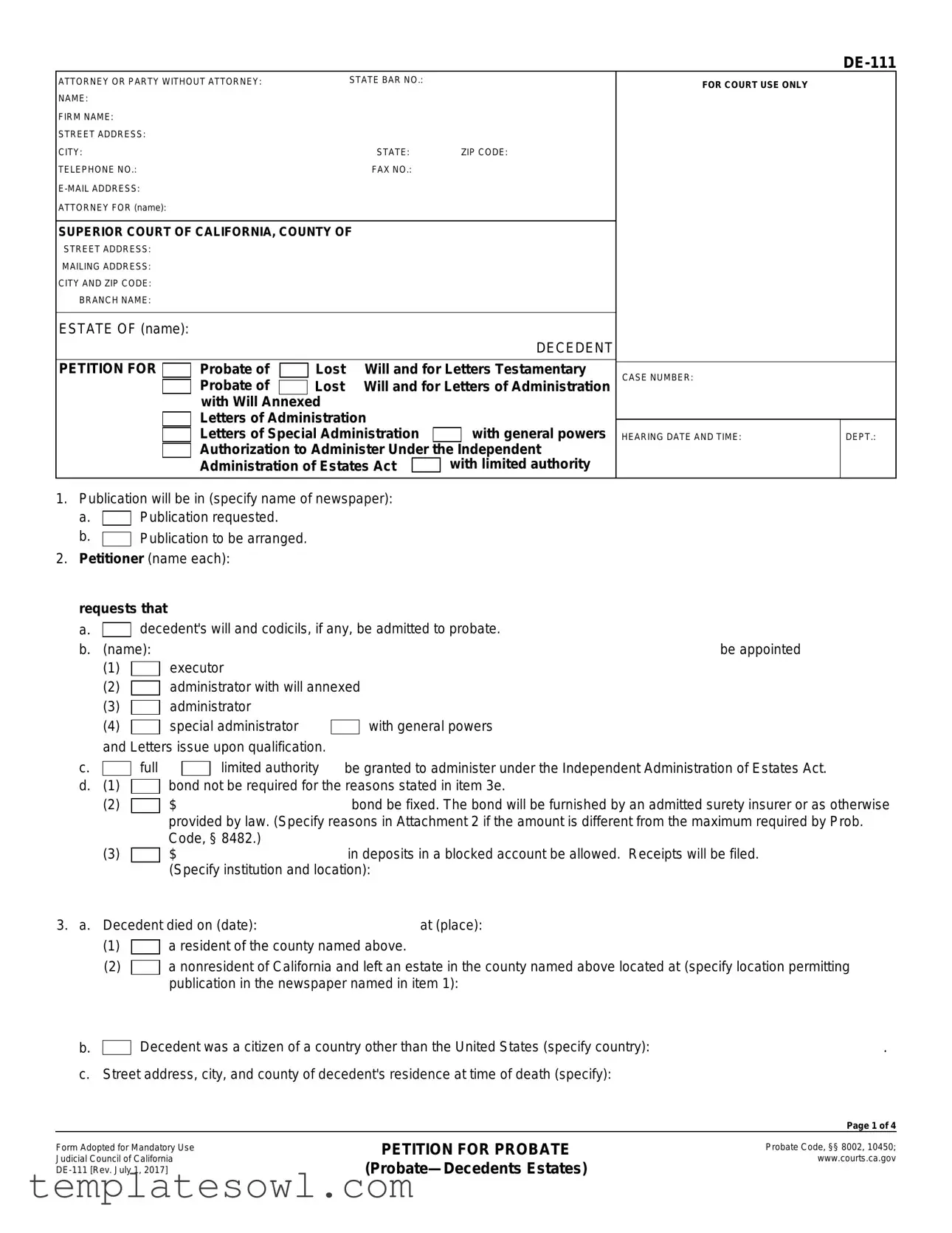3.d. Character and estimated value of the property of the estate (complete in all cases):
(1) |
Personal property: |
|
|
$ |
|
|
|
|
(2) |
Annual gross income from |
|
|
|
|
|
|
|
|
(a) |
real property: |
|
|
$ |
|
|
|
|
|
(b) |
personal property: |
|
|
$ |
|
|
|
|
(3) |
Subtotal (add (1) and (2)): |
|
|
$ |
|
|
|
|
(4) |
Gross fair market value of real property: |
$ |
|
|
|
|
(5) |
(Less) Encumbrances: |
|
|
($ |
) |
|
(6) |
Net value of real property: |
|
|
$ |
|
|
|
|
(7) |
Total (add (3) and (6)): |
|
|
|
$ |
|
e. (1) |
|
|
Will waives bond. |
|
Special administrator is the named executor, and the will waives bond. |
|
|
|
(2) All beneficiaries are adults and have waived bond, and the will does not require a bond. (Affix waiver as Attachment 3e(2).)
All beneficiaries are adults and have waived bond, and the will does not require a bond. (Affix waiver as Attachment 3e(2).)
(3) All heirs at law are adults and have waived bond. (Affix waiver as Attachment 3e(3).)
All heirs at law are adults and have waived bond. (Affix waiver as Attachment 3e(3).)
(4) Sole personal representative is a corporate fiduciary or an exempt government agency.
Sole personal representative is a corporate fiduciary or an exempt government agency.
f. (1)  Decedent died intestate.
Decedent died intestate.
|
|
|
|
|
|
|
|
(2) |
|
Copy of decedent's will dated: |
|
codicil dated |
(specify for each): |
|
|
|
|
are affixed as Attachment 3f(2). (Include typed copies of handwritten documents and English translations of foreign- |
|
|
language documents.) |
|
|
|
|
|
|
|
The will and all codicils are self-proving (Prob. Code, § 8220). |
|
|
|
|
|
|
(3) |
|
The original of the will and/or codicil identified above has been lost. (Affix a copy of the lost will or codicil or a written |
|
|
|
|
statement of the testamentary words or their substance in Attachment 3f(3), and state reasons in that attachment |
|
|
|
why the presumption in Prob. Code, § 6124 does not apply.) |
|
g.Appointment of personal representative (check all applicable boxes):
(1)Appointment of executor or administrator with will annexed:
(a) Proposed executor is named as executor in the will and consents to act.
Proposed executor is named as executor in the will and consents to act.
(b) No executor is named in the will.
No executor is named in the will.
(c) Proposed personal representative is a nominee of a person entitled to Letters. (Affix nomination as Attachment 3g(1)(c).)
Proposed personal representative is a nominee of a person entitled to Letters. (Affix nomination as Attachment 3g(1)(c).)
(d) |
|
Other named executors will not act because of |
|
death |
|
declination |
|
|
|
|
|
|
|
other reasons (specify): |
|
|
|
|
|
|
|
|
|
|
|
|
Continued in Attachment 3g(1)(d).
(2)Appointment of administrator:
(a) Petitioner is a person entitled to Letters. (If necessary, explain priority in Attachment 3g(2)(a).)
Petitioner is a person entitled to Letters. (If necessary, explain priority in Attachment 3g(2)(a).)
(b) Petitioner is a nominee of a person entitled to Letters. (Affix nomination as Attachment 3g(2)(b).)
Petitioner is a nominee of a person entitled to Letters. (Affix nomination as Attachment 3g(2)(b).)
(c) Petitioner is related to the decedent as (specify):
Petitioner is related to the decedent as (specify):
(3) Appointment of special administrator requested. (Specify grounds and requested powers in Attachment 3g(3).)
Appointment of special administrator requested. (Specify grounds and requested powers in Attachment 3g(3).)
(4) Proposed personal representative would be a successor personal representative. h. Proposed personal representative is a
Proposed personal representative would be a successor personal representative. h. Proposed personal representative is a
(1) resident of California.
resident of California.
(2)
 nonresident of California (specify permanent address):
nonresident of California (specify permanent address):


 Publication requested.
Publication requested.
 Publication to be arranged.
Publication to be arranged.
 decedent's will and codicils, if any, be admitted to probate.
decedent's will and codicils, if any, be admitted to probate.
 executor
executor
 administrator with will annexed
administrator with will annexed
 administrator
administrator a resident of the county named above.
a resident of the county named above. a nonresident of California and left an estate in the county named above located at
a nonresident of California and left an estate in the county named above located at 
 All beneficiaries are adults and have waived bond, and the will does not require a bond.
All beneficiaries are adults and have waived bond, and the will does not require a bond.  All heirs at law are adults and have waived bond.
All heirs at law are adults and have waived bond.  Sole personal representative is a corporate fiduciary or an exempt government agency.
Sole personal representative is a corporate fiduciary or an exempt government agency. Decedent died intestate.
Decedent died intestate. Proposed executor is named as executor in the will and consents to act.
Proposed executor is named as executor in the will and consents to act. No executor is named in the will.
No executor is named in the will. Proposed personal representative is a nominee of a person entitled to Letters.
Proposed personal representative is a nominee of a person entitled to Letters. 
 Petitioner is a nominee of a person entitled to Letters.
Petitioner is a nominee of a person entitled to Letters.  Petitioner is related to the decedent as
Petitioner is related to the decedent as 
 Proposed personal representative would be a successor personal representative. h. Proposed personal representative is a
Proposed personal representative would be a successor personal representative. h. Proposed personal representative is a resident of California.
resident of California.



















 died not more than 15 years before decedent and who owned an interest in
died not more than 15 years before decedent and who owned an interest in 
 died not more than five years before decedent and who owned
died not more than five years before decedent and who owned 
 Decedent was survived by issue of a predeceased spouse, all of whom are listed in item 8.
Decedent was survived by issue of a predeceased spouse, all of whom are listed in item 8.
 Decedent was survived by a parent or parents of the predeceased spouse who are listed in item 8.
Decedent was survived by a parent or parents of the predeceased spouse who are listed in item 8.
 Decedent was survived by issue of a parent of the predeceased spouse, all of whom are listed in item 8.
Decedent was survived by issue of a parent of the predeceased spouse, all of whom are listed in item 8.
 Decedent was survived by next of kin of the decedent, all of whom are listed in item 8.
Decedent was survived by next of kin of the decedent, all of whom are listed in item 8.
 Decedent was survived by next of kin of the predeceased spouse, all of whom are listed in item 8.
Decedent was survived by next of kin of the predeceased spouse, all of whom are listed in item 8.
 neither (1) nor (2) apply.
neither (1) nor (2) apply.